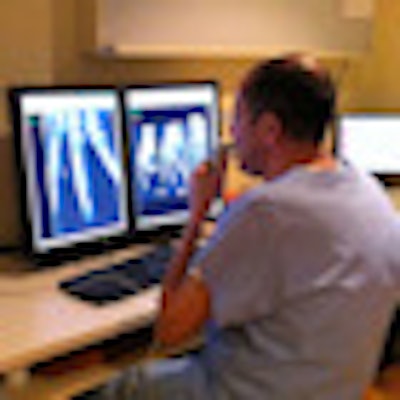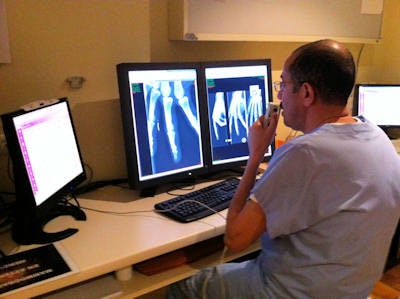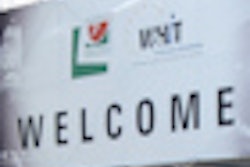
RIS are the backbone of imaging work flow, but according to the French Ministry of Health, only 30% to 40% of radiology departments in the country's public hospitals are equipped with a dedicated RIS. The rest use a general hospital information system that is not tailored to radiological needs.
The strength of the private sector partly explains the lack of dedicated informatics in French radiology. In France, there are about 8,000 radiologists, of whom 4,800 work as independent specialists. Private radiologists must pay for their system upgrades out of their own salaries. In a free market, such costs could be passed on to patients, but in France 92% of radiologists apply prices that are fixed by the government and don't even move in line with inflation. Public radiologists, on the other hand, are subject to long-winded public negotiations and a lengthy tender process, and may not end up with the optimal system for their department.
 A link from the DMP to a patient's images through PACS will take time, but will become feasible when PACS is widespread across France, according to Dr. Jean-Philippe Masson.
A link from the DMP to a patient's images through PACS will take time, but will become feasible when PACS is widespread across France, according to Dr. Jean-Philippe Masson.
"The product may even have been withdrawn commercially by the time hospitals are ready to purchase," said Dr. Jean-Philippe Masson, general secretary of Fédération Nationale de Médecins Radiologues (FNMR, French Union of Private Radiologists), vice president of France's telemedicine society ANTEL, and chief of the department of radiology at Clinic Montreal in Carcassonne.
However, there is a change in how informatics is viewed, spurred by the government's plan to modernize the country's health system through the dossier médical personnel (DMP), the equivalent of an electronic medical record or EMR. The DMP scheme, currently being piloted in several regions, is due to be officially implemented in 2012. Although DMPs will remain voluntary, their use is strongly encouraged by the French Ministry of Health. Radiologists planning to use them will have to ensure their own informatics systems are up to scratch, Masson explained. In terms of radiology data, the report is considered the most important element for inclusion in the DMP and will be sent as a PDF, accompanied by some key images but fewer than five.
"Radiologists would agree that it is reasonable for images to be illustrative. However, they do want to work toward creating a link from the report to a place where all the images are stored, and it is possible with a PACS, so that a doctor can access these images from the DMP," Masson said.
Although regional PACS is currently being implemented in another governmental pilot scheme, a national network to access such a store doesn't seem possible at present, with various reasons cited, including costs and integration.
 Dr. Abdel Tijari uses the RIS (left screen) and PACS (right screen) at the Clinic Montreal, Carcassonne in France. Images courtesy of Dr. Jean-Philippe Masson.
Dr. Abdel Tijari uses the RIS (left screen) and PACS (right screen) at the Clinic Montreal, Carcassonne in France. Images courtesy of Dr. Jean-Philippe Masson."In the here and now, the government is reluctant to interfere in private PACS particularly as there are problems establishing real interoperability between the different systems using DICOM, HL7, and IHE. They speak the same languages, but each company has a heavy accent and communication glitches are common," noted Masson, pointing to an expensive interface needed between his clinic's RIS and PACS, built at an extra cost by the companies servicing his practice.
PACS development is not advanced in France. Only 20% to 30% of public hospitals have PACS. The figures are better in the private sector: 80% of independent radiologists have some sort of image archiving system, but only around 30% to 40% have a real PACS.
"There are so few PACS in France at present that such a link from the DMP wouldn't be useful. The link to an image store will come, but this will take time and will occur when PACS is better established across the country," he said.
In the meantime, the government has tasked the various radiology unions in France to ensure smooth communication of radiology reports to the DMP. Three years ago, members of FNMR, the French Society of Radiology (SFR), the union of public radiologists, Syndicat des radiologues hospitaliers (SRH), and the national union for teachers of radiology, Conseil des Enseignants en Radiologie de France (CERF) formed the Association for Personal Records in Medical Imaging (Association pour le Dossier Personnel en Imagerie Médicale [ADPIM]). ADPIM is working with RIS companies throughout France to develop interoperability protocols so that each private RIS can communicate with the DMP.
"We will be testing protocols on 100 departments of radiology -- half public, half private -- including both clinics and hospitals from September to the end of the year. After this, the system will be deployed nationwide," Masson said.
Editor's Note: AuntMinnieEurope.com readers should be aware that ANTEL is not a commercial organization.



















